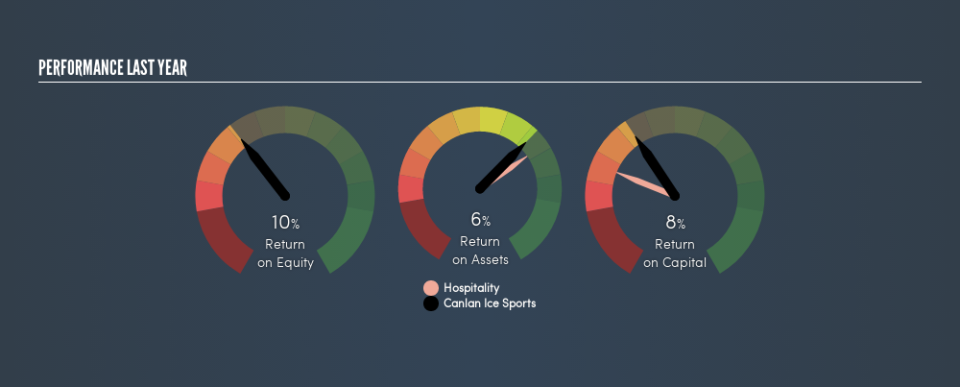Does Canlan Ice Sports Corp. (TSE:ICE) Create Value For Shareholders?

Want to participate in a short research study? Help shape the future of investing tools and receive a $20 prize!
Today we are going to look at Canlan Ice Sports Corp. (TSE:ICE) to see whether it might be an attractive investment prospect. Specifically, we’ll consider its Return On Capital Employed (ROCE), since that will give us an insight into how efficiently the business can generate profits from the capital it requires.
Firstly, we’ll go over how we calculate ROCE. Next, we’ll compare it to others in its industry. And finally, we’ll look at how its current liabilities are impacting its ROCE.
Understanding Return On Capital Employed (ROCE)
ROCE is a measure of a company’s yearly pre-tax profit (its return), relative to the capital employed in the business. All else being equal, a better business will have a higher ROCE. In brief, it is a useful tool, but it is not without drawbacks. Author Edwin Whiting says to be careful when comparing the ROCE of different businesses, since ‘No two businesses are exactly alike.’
How Do You Calculate Return On Capital Employed?
Analysts use this formula to calculate return on capital employed:
Return on Capital Employed = Earnings Before Interest and Tax (EBIT) ÷ (Total Assets – Current Liabilities)
Or for Canlan Ice Sports:
0.08 = CA$5.8m ÷ (CA$124m – CA$27m) (Based on the trailing twelve months to September 2018.)
Therefore, Canlan Ice Sports has an ROCE of 8.0%.
Check out our latest analysis for Canlan Ice Sports
Is Canlan Ice Sports’s ROCE Good?
One way to assess ROCE is to compare similar companies. We can see Canlan Ice Sports’s ROCE is around the 9.3% average reported by the Hospitality industry. Setting aside the industry comparison for now, Canlan Ice Sports’s ROCE is mediocre in absolute terms, considering the risk of investing in stocks versus the safety of a bank account. Readers may find more attractive investment prospects elsewhere.
Our data shows that Canlan Ice Sports currently has an ROCE of 8.0%, compared to its ROCE of 3.8% 3 years ago. This makes us wonder if the company is improving.
It is important to remember that ROCE shows past performance, and is not necessarily predictive. ROCE can be misleading for companies in cyclical industries, with returns looking impressive during the boom times, but very weak during the busts. ROCE is only a point-in-time measure. You can check if Canlan Ice Sports has cyclical profits by looking at this free graph of past earnings, revenue and cash flow.
What Are Current Liabilities, And How Do They Affect Canlan Ice Sports’s ROCE?
Short term (or current) liabilities, are things like supplier invoices, overdrafts, or tax bills that need to be paid within 12 months. Due to the way the ROCE equation works, having large bills due in the near term can make it look as though a company has less capital employed, and thus a higher ROCE than usual. To check the impact of this, we calculate if a company has high current liabilities relative to its total assets.
Canlan Ice Sports has total liabilities of CA$27m and total assets of CA$124m. As a result, its current liabilities are equal to approximately 22% of its total assets. This very reasonable level of current liabilities would not boost the ROCE by much.
Our Take On Canlan Ice Sports’s ROCE
If Canlan Ice Sports continues to earn an uninspiring ROCE, there may be better places to invest. Of course you might be able to find a better stock than Canlan Ice Sports. So you may wish to see this free collection of other companies that have grown earnings strongly.
If you like to buy stocks alongside management, then you might just love this free list of companies. (Hint: insiders have been buying them).
We aim to bring you long-term focused research analysis driven by fundamental data. Note that our analysis may not factor in the latest price-sensitive company announcements or qualitative material.
If you spot an error that warrants correction, please contact the editor at editorial-team@simplywallst.com. This article by Simply Wall St is general in nature. It does not constitute a recommendation to buy or sell any stock, and does not take account of your objectives, or your financial situation. Simply Wall St has no position in the stocks mentioned. Thank you for reading.

 Yahoo Finance
Yahoo Finance 
